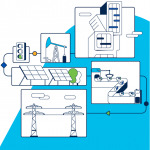At Cisco, we’ve always been strong believers in the Internet of Things. Today we’re in the age of a digital transformation where billions of connected devices are communicating with each other, the edge, and the cloud. Industrial automation is pervasive across factories and farms, manufacturing, facilities and mines. Connected devices are monitoring our energy grid and ensuring the safety of emergency responders.
IoT is changing how businesses operate and driving an IT OT convergence. But creating secure networks of autonomous machines is not something anyone should take for granted. It’s not enough to simply connect everything; you also need to intelligently manage all those devices. You need a way to measure and optimize your operating costs to avoid unplanned expenses and downtime, to diagnose problems and optimize network performance, to secure data in transit and prevent devices from being compromised, to scale your operations. And you need tools that help you take the vast amounts of data these devices generate and put it to use.
No one company can do all of this all alone. That’s why I’m so pleased to announce that Cisco IoT has extended our partnership with AT&T to manage IoT devices for enterprises.
Cisco + AT&T: A deep connection
For more than a dozen years, Cisco and AT&T have worked together to provide connectivity to our industrial customers. Using the Cisco IoT Control Center platform, AT&T offers their enterprise customers visibility into more than 70 million IoT devices across virtually every sector of the economy – including manufacturing, automotive, utilities, transportation, and the public sector.
In 2013, for example, a well-known car manufacturer deployed Cisco IoT Control Center to manage connectivity for its fleet of connected vehicles, which today generate upwards of 2.3 TB of data an hour. Control Center gave the manufacturer the tools to deploy and scale vehicle rollouts, manage cost of operations, and monetize services within the vehicle.
Control Center proved so useful that the car maker collaborated with Cisco on a proof-of-concept project, deploying our industrial OT cyber security solution, called Cyber Vision on their factory floor. Cyber Vision is embedded in our industrial networking providing full visibility into their Industrial Control System operations, including dynamic asset inventory, real-time monitoring of control networks and process data, and comprehensive threat intelligence to control risk.
The manufacturer is now looking at deploying Cyber Vision alongside Cisco Industrial Ethernet 2000 and 3000 Series Switches throughout its production facilities.
While car manufacturers are quickly adopting IoT, an example of how Cisco and AT&T are working together to solve real-world problems is through the First Responder Network Authority (FirstNet).
A public-private partnership between the U.S. federal government and AT&T, FirstNet is a dedicated wireless broadband network that connects thousands of emergency responders across the nation. Work is already underway to bring connected devices such as government building management systems, roadways, and traffic intersections onto AT&T’s FirstNet network, using FirstNet Ready™ Cisco 1101 Integrated Services Router Rugged (IR1101).
Every day, Cisco and AT&T are working together to help save lives by improving the speed and efficiency of emergency response.
IoT will impact every industry
But we’ve barely scratched the surface. By 2030, the number of connected devices in the world will be somewhere between 25 billion and 125 billion.
No matter which estimate you believe, that’s still a lot of IoT. The number of potential use cases we are addressing is virtually unlimited. Here are a few examples:
- Energy. Millions of smart meters help utility companies to identify outages and enable their customers to consume less power. But utilities can also use a combination of industrial switches, gateways, private LTE/5G IoT to automate their substations, allowing them to lower costs and improve customer service.
- Transportation. By taking advantage of wireless network communications technologies, container terminals can be operated remotely, lowering costs while boosting safety. IoT can also help shippers track cargo, navigate more efficiently, and reduce losses from damaged goods, saving them billions of dollars.
- Manufacturing. IoT is the heart of Industry 4.0 and Digital Factories. I have seen connected devices on the factory floor cut production cycles by well over 20%, and reduce defects and downtime by half in some of our customers.
- Mining. Cisco’s connected mining solutions have already been installed in thousands of locations worldwide, allowing mine operators to boost equipment reliability, reduce maintenance costs, respond more quickly to emergencies, and increase employee safety.
- Smart cities. Municipalities are using connected devices to reduce pollution, cut costs, and deliver better services to citizens. In dozens of cities around the world, sensors embedded in traffic lights and roadways work to regulate the flow of cars, while automated lighting systems have been shown to reduce energy bills and crime.
- Security and safety. Thousands of office buildings, airports, roadways, and other facilities are protected by Cisco connected safety and security products, which includes IP cameras, industrial gateways, and cellular connections, as well as the software to manage them.
That’s just a small sample of how connected devices are transforming virtually every industry. This change is happening in real time. All enterprises need to start thinking about how IoT can accelerate their digitization initiatives and drive business outcomes.
Learn more about the Cisco and AT&T partnership in our press release.
Disclaimer: FirstNet® and FirstNet® Ready are registered trademarks and service marks of the First Responder Network Authority.

This is timely and need of hour especially in era of Edge computing. Thanks for sharing
nice
Hi, thanks for this informative blog it is really helpful.
I agree that IoT solutions in manufacturing will bring digital transformation that will streamline the production and make the manufacturing process centrally connected.
IoT-ing construction operations will increasingly help decrease downtime with better-performing systems and optimizing the entire construction process with advanced resource allocation.
So yes we can say that IoT is the future of every industry.